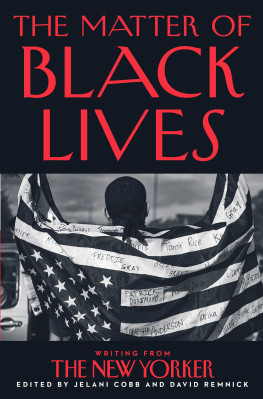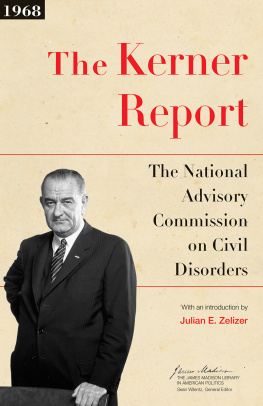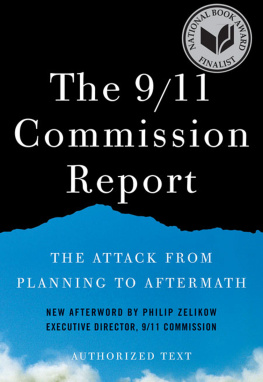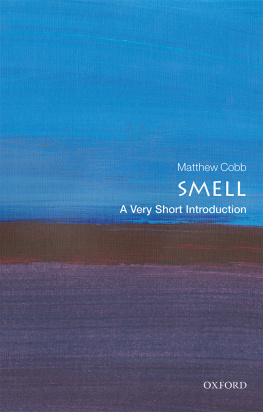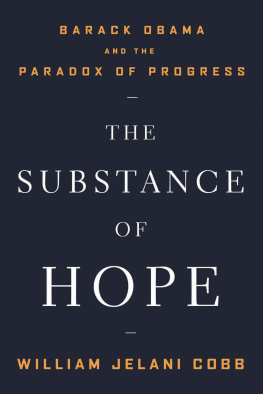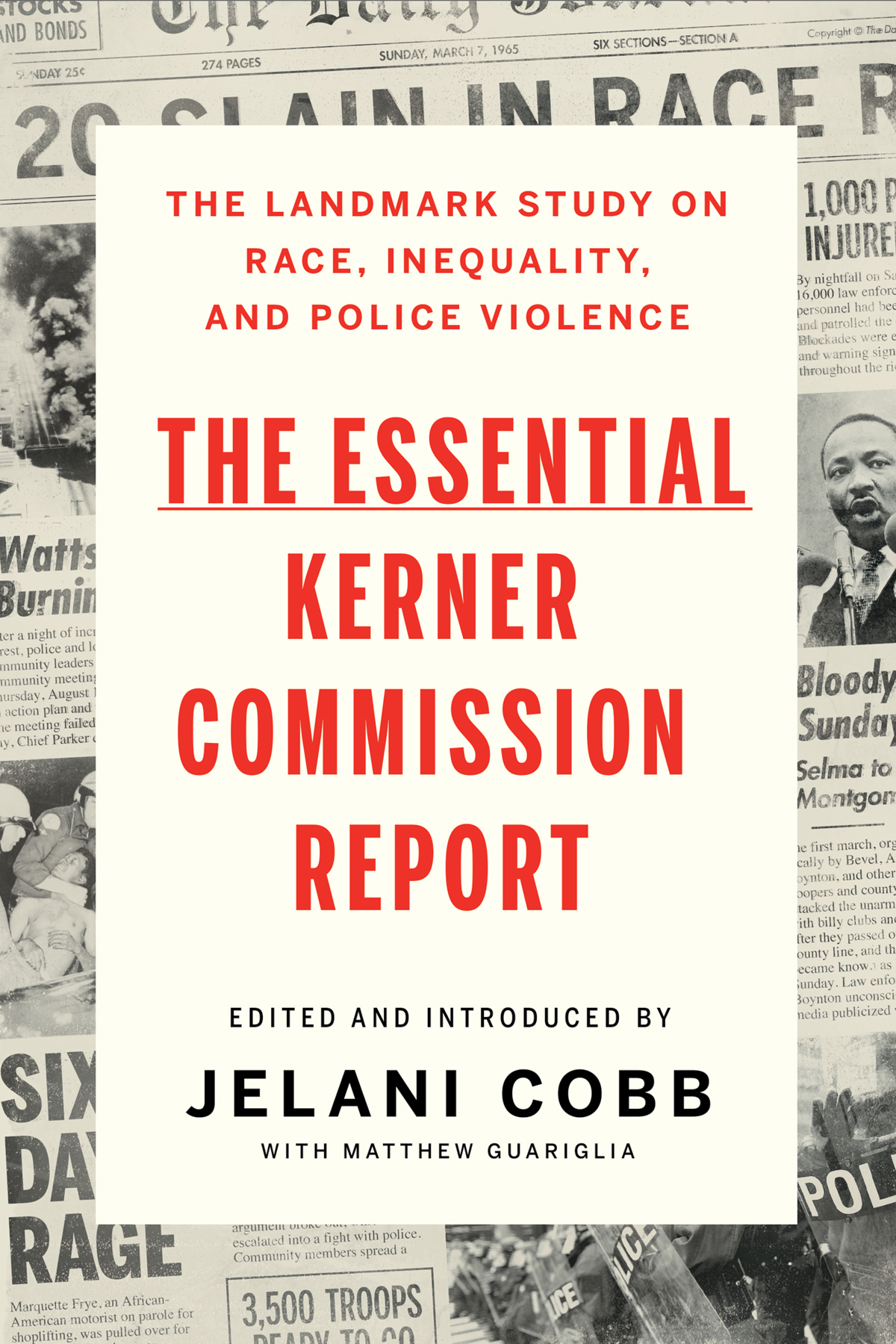Contents
Guide
Page List
THE ESSENTIAL
KERNER
COMMISSION
REPORT
EDITED AND INTRODUCED BY
Jelani Cobb
with Matthew Guariglia
LIVERIGHT PUBLISHING CORPORATION
A Division of W. W. Norton & Company
Independent Publishers Since 1923
For Lenox, my bright star in the night sky.
CONTENTS
by Jelani Cobb
THE ESSENTIAL KERNER COMMISSION REPORT
The following table of contents is a redacted version of the original contents page of The Kerner Commission Report
1.
The findings of the Kerner Commission exist alongside those of the Warren and 9/11 Commissions among the handful of governmental reports whose historic import has outlived the moment in which they were issued. The Warren Report, intended to be the last word on the assassination of President John F. Kennedy, has been anything but, launching more inquiry and debate, not to mention conspiracy theories, in its wake than existed prior to its publication. The 9/11 Commission Report, issued in the summer of 2004, traced the origins of the terrorist attacks that destroyed the World Trade Center, which had killed 2,753 people three years earlier. In so doing it became an essential guide to understanding the (ongoing) era of American politics that is defined by and continues to operate in response to the events of that indelible September morning.
The Kerner Commission Report, however, is different. The Warren and 9/11 reports are concerned with singular events, tragedies that have remained unique in either scale or kind since they were examined. They function as primary sources in history. The Kerner Commission, more formally known as The National Advisory Commission on Civil Disorders, details an extant problem, one that is defined by its redundancy. This was apparent even at the outset of the reports existence. When President Lyndon B. Johnson created the commission in July 1967 it was tasked with understanding what had happened up to that moment. Nearly two dozen uprisings or, in the antiseptic language of the report, civil disorders, had occurred between 1964 and 1967, with the largest and most destructive taking place in the Watts neighborhood in Los Angeles over the course of five days in August 1965. The commission could not have known when it released its findings in March 1968 that it was issuing a preface, not a postscript. Martin Luther King Jr. was assassinated the following month, and more than one hundred American cities exploded into just the type of violence that the Kerner Commission had sought to understand if not prevent.
The proximity of the two eventsthe reports release and Martin Luther Kings deathallowed for people to, over time, conflate them. It is not uncommon for people to believe that the Kerner Commission examined the unrest of the entire sixties rather than just the first installment of them. But the timing is important if only because the Kerner Report was fated, from the moment it reached shelves, to operate more crucially as a forecast than a review. We hear George Santayanas dictum that those who fail to learn from history are doomed to repeat it quoted with eye-rolling frequency. But Kerner establishes that it is possible for us to be entirely cognizant of history and repeat it anyway. Never was this more apparent than in the spring of 2020 when the half-century-old report reemerged as part of the stilted national dialogue on race, policing, and inequality.
Around 8:00 p.m. on the spring evening of May 25, 2020, four Minneapolis police officers arrested George Perry Floyd, a forty-six-year-old Black man, for allegedly passing a counterfeit twenty-dollar bill at a local convenience store. In the course of the arrest the part-time bouncer was handcuffed and beaten while inside a patrol car. The police assault culminated in Mr. Floyd lying on the pavement next to the car, still handcuffed, while a forty-four-year-old white officer, Derek Chauvin, cavalierly kneeled on his neck for at least eight minutes and forty-six seconds. Chauvin kept his knee in place despite the pleas of nearby observers who cried out that Floyd needed medical attention, despite Floyds repeated assertions I cant breathe and Theyll kill me, while crying out to his deceased mother for help. When Chauvin at long last relented, George Floyd was unconscious. He was taken by ambulance to a nearby hospital where he was pronounced dead.
The official police report on the matter made no mention of the methodical asphyxiation and falsely accused the deceased of having resisted arrest. This was immediately contradicted by a video of the incident taken by Darnella Frazier, a Black seventeen-year-old passerby, who happened upon the scene as she was walking her young cousin to the store. The footage revealed a brutal, collaborative effort to extinguish George Floyds life. At various points multiple officers were involved in compressing the victims chest and airway.
The reaction to Floyds death was immediate. The following day protesters began gathering on the 3700 block of Chicago Avenue South where Floyd had been killed. In a Facebook post the following morning, Jacob Frey, the mayor of Minneapolis, observed that being black in America should not be a death sentence. He continued:
For five minutes, we watched a white officer press his knee into a Black mans neck. Five minutes. When you hear someone calling for help, youre supposed to help. This officer failed in the most basic, human sense. What happened on Chicago and 38th last night is awful. It was traumatic. It serves as a reminder of how far we have to go.
Later that day Minneapolis police chief Medaria Arradondo summarily fired all four officers, an action Frey described as the right call. The following day he called for criminal charges. The hasty bureaucratic reaction could not, however, stave off a tempest of outrage that was building even as the officers were being removed from the police force. By evening hundreds of protesters with signs saying Stop Killing Black People had swarmed into the streets of Minneapolis, gathering at the site of Floyds death and at the Third Precinct, where the police officers who killed him had worked. The sustained protests turned sporadically violent with looting and arson in the area surrounding the site of Floyds death, which would turn into a shrine shortly thereafter. On May 28, a multiracial crowd of demonstrators returned to the Third Precinct and, after police posted there abandoned the building, proceeded to burn it to the ground. Simultaneously, the video of Floyds death circulated around the Internet, reaching a public that had been largely locked down due to the emergence of a coronavirus pandemic. The quarantine guaranteed that there would be few distractions to mitigate the horror of what transpired in Minneapolis. The video ricocheted around on social media, its gruesome content sparking new infernos of outrage wherever it landed. By May 2020 there were enough recordings of civilian deaths at the hands of police to nearly constitute a genre of video. A disproportionate number of those images depicted the deaths of African Americans. And as with any repetitive horror, there was growing concern on the part of activists and advocates that the public was becoming inured to the brutality being captured (largely on cell phones) with terrible redundancy. The images of George Floyds death landed differently in part because of the excruciating length of the videohe was asphyxiated over the course of nearly nine minutes, an act that required profound and abhorrent levels of sadism from the police who committed it. This was one reason that the Floyd protests, some of them checkered with arson and looting, spread from an insulated locale on the south side of Minneapolis to Los Angeles, Atlanta, Washington, DC, New York, Salt Lake City, Chicago, Anchorage, and dozens of other American cities within days.


